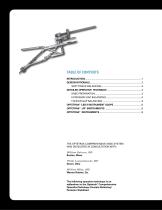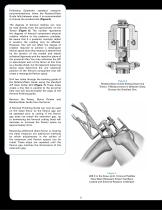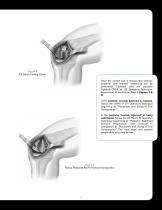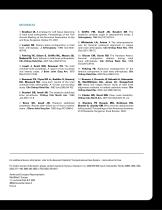
Catalog excerpts

Operative Technique Addendum to: Optetrak® Cruciate Retaining/Posterior Stabilized Operative Technique Ligament Balancing System Second Generation The Right Track It’s not just a road we’re on, it’s a trail we’re bl
Open the catalog to page 1
The optetrak Comprehensive knee System was developed in consultation with: William Balcom, MD Boston, Mass. Philip Lewandowski, MD Akron, Ohio William Wiley, MD Warner Robins, Ga. The following operative technique is an addendum to the Optetrak® Comprehensive Operative Technique Cruciate Retaining/ Posterior Stabilize
Open the catalog to page 2
The necessity of balanced flexion and extension gaps in total knee replacement surgery has been well proven. improper balance has been shown to result in inferior clinical results.1,2,12,13 Symmetric and equal flexion and extension gaps are required to ensure proper kinematics of the joint and optimize function, range of motion and stability. Balancing of flexion and extension gaps requires proper varus/valgus alignment, rotational alignment and sizing of both femoral and tibial components. Accurate varus/valgus alignment is achieved through pre-operative planning, reliable...
Open the catalog to page 3
Design Rationale Since most degenerative arthritic knees exhibit varus or valgus misalignment, the traditional approach has always been to perform medial or lateral soft tissue releases depending on the deformity, including releases of the medial collateral ligament in (MCL) severe varus knees. Reported medial collateral ligament release rates range from 12-44 percent. While ligamentous release can produce the desired realignment, it may also create leg length discrepancy, flexion-extension mismatch or unnecessary soft tissue surgery. The rationale behind the development of the Ligament...
Open the catalog to page 4
soft tissue balancing it has been shown that the lateral collateral ligament (LCL) may lengthen up to 3mm with varus deformity of up to 20 degrees, and also that the Md does not elongate with valgus deformities of up to 15 degrees.1 These observations have concluded that: The lateral side is adjustable because it: ■ Elongates or shortens in face of deformity ■ Contracts (valgus deformity) ■ Lengthens (varus deformity) The MCL is the reference datum for: ■ Flexion gap ■ Extension gap ■ Angular alignment Apparent tightness of the collateral ligaments results from underlying osteophytes on...
Open the catalog to page 5
important so as to ease balancing the flexion and extension spaces. The varus/valgus plane for the distal femoral cut may be influenced by patient height and the degree of pre-operative coronal knee deformity. The coronal plane of the proximal tibial resection can be confirmed with a small provisional tray and attached alignment rod. Extension Gap Balancing Using the Tibial Flexion/Extension Spacer Blocks, choose the correct thickness that will allow the joint to achieve full extension. An acceptable degree of medial/lateral laxity should be allowed. The use of spacer blocks ensures that a...
Open the catalog to page 6
Figure 4 Tensor Rod Inserted into Intra-medullary Canal The next step in the procedure will be to balance the knee in flexion to create a rectangular flexion gap and to apply equal tension on both the medial and lateral collateral ligaments. Do not evert the patella to avoid over-tensioning the lateral side. Gentle tension is applied to the Tensor. The femur auto-rotates around the LBS II Tensor Rod and stops when there is equal tension on the collateral structures. At this point, proper balance between the medial and lateral collateral ligaments is achieved. Tighten the nut on the Tensor...
Open the catalog to page 7
Following Optetrak’s standard resection recommendations, when the Rotation/Sizer Guide falls between sizes, it is recommended to choose the smallest size (Figure 6). The degrees of femoral rotation can now be read directly from the goniometer on the Tensor (Figure 6). The number represents the degrees of femoral component external rotation relative to the posterior condyles. Be aware that if a posterior condylar defect is present, the reading may be affected. However, this will not affect the degree of rotation required to achieve a rectangular flexion space since that rotation is...
Open the catalog to page 8
Figure 8 PS Notch Cutting Guide Once the correct size is chosen, the anterior, posterior and chamfer resections can be performed. Continue with the standard Optetrak CR/PS or LPI Operative Technique, Preparation of the Femur, Step 6 (Figures 8 & 9). If the posterior cruciate ligament is retained, follow the CR/PS or LPI Operative Technique beginning at “Placement and Sizing of Trial Components. ” If the posterior cruciate ligament is being substituted, follow the CR/PS or LPI Operative Technique beginning at “Posterior Stabilized Femoral Preparation” and continue to completion at “Placement...
Open the catalog to page 9
OPtetrak® LBS II instrument scope OPtetrak® LPI® instruments 213-41-06 LPI Beta Stylus Pointer Optetrak Tibial Flexion/Extension Spacer Blocks (not pictured), 9mm Optetrak Tibial Flexion/Extension Spacer Blocks (not pictured), 11mm Optetrak Tibial Flexion/Extension Spacer Blocks (not pictured), 13mm Optetrak Tibial Flexion/Extension Spacer Blocks (not pictured), 15mm Optetrak Tibial Flexion/Extension Spacer Blocks (not pictured), 18mm
Open the catalog to page 10
1. Gradisar IA. A strategy for soft tissue balancing in total knee arthroplasty. Proceedings of the 11th Annual Meeting of the American Association of Hip and Knee Surgeons. Dallas, Tx. 2001. 2. Laskin RS. Flexion space configuration in total knee arthroplasty. J Arthroplasty. 1995 Oct;10(5): 657-60. 3. Fehring TK, Odum S, Griffin WL, Mason JB, Nadaud M. Early failures in total knee arthroplasty. Clin Orthop Relat Res. 2001 Nov;(392):315-8. 4. Insall J, Scott WN, Ranawat CS. The total condylar knee prosthesis. A report of two hundred and twenty cases. J Bone Joint Surg Am....
Open the catalog to page 11
Exactech is proud to have offices and distributors around the globe. For more information about Exactech products available in your country, please visit www.exac.com ©2010 Exactech, Inc. • ISO 13485 Certified
Open the catalog to page 12All Exactech catalogs and technical brochures
-
AcuMatch
7 Pages
-
Hip Family Brochure
9 Pages
-
Corporate Product Brochure
5 Pages
-
Biologics
9 Pages
-
Corporate brochure
11 Pages
-
Cemex_Main_
12 Pages
-
Calcium Phosphate Cement
5 Pages
-
EXACTECH HIP
8 Pages
-
Bipolar/Unipolar Heads
2 Pages
-
Novation
16 Pages
-
Equinoxe Fx Plate
2 Pages
-
Equinoxe Product
2 Pages
-
Equinoxe Reverse
8 Pages
-
Equinoxe System
7 Pages
-
Novation CFS
2 Pages
-
AcuMatch_Family
20 Pages
-
knee replacement
5 Pages
-
Spacer
4 Pages
-
accelerate
3 Pages
-
Element
16 Pages
-
EXACTECH HIP Design Rationale
12 Pages
-
EXACTECH HIP Operative Technique
16 Pages




























